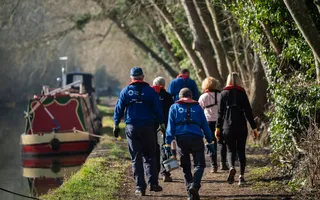One of the more interesting topics in the fisheries world over the past few years has been the debate, which at times has been extremely heated, around the spread of non-native fish species in our waterways, especially zander.
Led by Eric Edwards, a well-known and respected predator angler and chaired by Mark Owen, Angling Trust with the support of Canal & River Trust recently organised a workshop to which key representatives of bona fida organised groups, clubs and organisations were invited to attend and contribute. I was privileged to be asked to represent the 120 or so active Let's Fish! coaches.
Current regulatory position on returning zander
We heard from Dave Ottewell (Natural England) and two representatives from the EA, plus Natural Resources Wales, who had prepared an advanced slide setting out their position about zander in Wales. My interpretation of what Dave had to say was that except for the Fenland rivers where zander were introduced legally by the then water authority, the Wildlife & Countryside Act 1981 would most certainly currently apply. The relevant clauses state:
-
Section 14 W&CA prohibits introduction into the wild of any animal which is not ordinarily resident in, and is not a regular visitor to, Great Britain in a wild state, or any species of animal or plant listed in Schedule 9 to the Act
-
Schedule 9 lists non-native species already established in the wild, which continue to pose a conservation threat to native biodiversity and habitats. Zander are listed as Schedule 9 species
So as the law currently stands, anglers can be prosecuted for illegally returning zander and it would be up to the police whether to take this prosecution forward based on the evidence.
The EA went on to explain that a risk assessment was currently being carried out in relation to the future keeping of zander, which would be available to the public for consultation soon. The EA then went on to explain the Keeping & Introduction of Fish Regulations 2015 (KIFR).
Rock and a hard place
A little piece of me was expecting fireworks to make an appearance when John Ellis came up to speak. Luckily the audience was made up of sensible and generally knowledgeable folk who appreciated the complexity of the situation, whichever side of the fence they happened to sit. In a lengthy presentation, John expanded on the nature of the Trust's current KIFR permits. At the end of his presentation, various canal stakeholder groups, getting on for a dozen in total, followed with an all too brief opportunity to present their views.
On illegal introduction
I take my hat off to the various pro zander representatives for there were, best I could tell, no dissenting voices to the view that zander has been stocked illegally in the canal network at some stage during the 1970s and spread through some of the Midlands system. Everyone totally condemned further illegal introduction. It therefore logically follows, and nobody appeared to argue to the contrary, that action to manage any illegal introduction and limit the impact of these illegal introductions is entirely reasonable, thus supporting the Trust's current work, which is supported by numerous stakeholders.
It was pleasing that so many people backed up the current approach that has been endorsed consistently by the national advisory group and the FAAP steering group. Best I could tell, there was not a single dissenting voice in the room to the concept of preventing further spread both to new areas of canal and associated river catchments, helping maintain and restore the traditional fishery on the Grand Union Canal, preventing the establishment of new isolated populations or helping restore SSSIs to favourable status.
Revisiting Midlands canals zander zone
In what I felt was a pragmatic presentation looking to highlight win: win options; John Ellis raised his desire to revisit the possibility of a small Midlands canal zander zone under KIFR the whereby zander could be legally kept by Canal & River Trust and thus returned alive by anglers without fear of prosecution. This had been applied for in 2015 by the Trust which surprised me a little for the Trust seems to receive so much negative publicity on social media and yet here they had tried, albeit unsuccessfully, to support the pro zander cause. The 2015 application was not granted by the regulators and following any further application it would of course be up to the regulators to give consent to this or not.
Assumedly, this proposed zone would be based on the patches of the two clubs who rent fishing predominantly, although not exclusively, for zander fishing. This is something personally I think I could support in exchange for the pro zander group formally supporting the current ongoing removal work at other locations. This pragmatic compromise would hopefully start to heal rifts within the wider angling community, thus I do hope that it is possible for the regulators to support such a pragmatic proposal. However, I do appreciate their difficulty for allowing one non-native invasive species to persist could encourage miscreant anglers to think about illegally stocking the next non-native invasive species they would like to fish for.
Eradication
John's presentation also touched on the hypothetical prospects of eradication, something that John suggested was with great effort certainly possible in the narrow canal network but which he seemed highly reluctant to have to pursue unless the regulators insisted on it. It was clear that it would take an extraordinary set of circumstances to achieve complete draindown of the deep and wide Gloucester & Sharpness Canal, which in any event is linked to the River Severn, so a pragmatic approach would be to allow zander to be returned here by those anglers who wish to do so, a point also picked up on by the Institute of Fisheries Management. John also asked for views on the possibility of creating zander fisheries at totally enclosed stillwaters; something worth looking at if there are fishery owners who may be interested, and the regulators are prepared to allow it.







